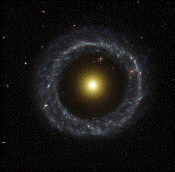
Astronomy
Lab: Observing Jupiter's Moons

Astronomy Lab Instructions
The Rings of Jupiter or Saturn
Goal: To observe the Rings of Jupiter and/or Saturn.
Materials:
- Telescope, binoculars with 8X
- Pencil, paper for notes and drawings
- Sky and Telescope
Procedure
- Use Stellarium or some other planetarium program to determine when Jupiter and Saturn will be in good position (higher than 10° above the horizon), will little interference from the moon.
- Determine the expected position of the moons of Jupiter and Saturn. [You can do this from some planetarium applications but also from the Rings Node Online Tools page at the JPL Planetary Data Center.
- Click on the Moon Tracker for Jupiter.
- Enter the Start for the observing period. For this lab, enter 12:00:00 am January 30, (Current year) to start at midnight on the morning of January 30, London (UNIVERSAL) TIME.
- Enter an end time at least two WEEKS later than your start time, i.e. 12:00:00 am February 14, (Current Year).
- Enter 1 hour as the Plot Interval.
- Enter 27 Jupiter radii for the Plot Scale to allow you to see Callisto's position.
- Check the moons Io (3 radii), Europa (5 radii), Ganymede (8 radii), and Callisto (13.5 radii). You could plot the others, but unless you have a high-powered telescope and excellent observing conditions, you will probably not be able to find them.
- Leave the rings unchecked
- Click on "Render diagram"
- Download your diagram as a PDF file.
- Reading the Tracker output.
- Assume when looking at the diagram that you are looking southward at the equatorial plane from the northern hemisphere. The center dark band is Jupiter's disk. Left is to the east, right is to the west.
- When is Callisto at maximum eastward elongation? When is it at maximum westward elongation? Based on these observations, what is Callisto's orbital period?
- When is Ganymede at maximum eastward elongation? When is it at maximum westward elongation? Based on these observations, what is Ganymede's orbital period?
- When is Europa at maximum eastward elongation? When is it at maximum westward elongation? Based on these observations, what is Europa's orbital period?
- When is Io at maximum eastward elongation? When is it at maximum westward elongation? Based on these observations, what is Io's orbital period?
- Make a table of your observational data and period calculations. How does Io's period compare with Europa's? With Ganymede's? With Callisto's? Is there any orbit coupling between any of these four moons?
- Create a similar table for Saturn's moons Mimas, Tethys, Rhea, Iapetus, and Titan. Do you detect any orbit coupling between these moons?
- Use the Planet viewer options to create a diagram showing the position of the rings and moons of Jupiter at 12:00:00am on January 15, 2012. Assume a scale of 12 planetary radii.
Report
Write a report of all your observations and post it to your thread in the Astronomy Forum at the Scholars Online Moodle Astronomy Page. Your report should include
- The parameters you used to generate your "observations" of the moons and rings of Jupiter and Saturn.
- Your data for the maximum elongation times of the moons.
- Sample calculations demonstrating how you determined the lunar orbital periods.
- Your conclusions about coupling between the moons.
© 2005 - 2025 This course is offered through Scholars Online, a non-profit organization supporting classical Christian education through online courses. Permission to copy course content (lessons and labs) for personal study is granted to students currently or formerly enrolled in the course through Scholars Online. Reproduction for any other purpose, without the express written consent of the author, is prohibited.